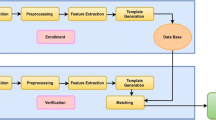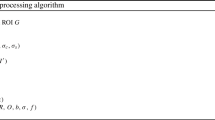Abstract
Finger vein recognition has advantages that can’t be replaced by other biometrics. Our designed system employs the feature vectorization pattern and multiple strategies, such as Arcloss, image enhancement designed in this paper and luminance-inversion data augmentation. Compared with the other algorithms using classifiers, this system is open-set testable and doesn’t require additional computer resource for new category registration, which is more in line with practical application requirements. The recognition rate of this system is up to 99.8% in closed-set test on two public databases, and the recognition rate keeps acceptable when the training samples are reduced. The recognition rate can reach about 95% in cross open-set test. This paper also proposes two optimal threshold determination strategies to determine whether a category is registered or not.
Access this chapter
Tax calculation will be finalised at checkout
Purchases are for personal use only
Similar content being viewed by others
References
Hong, H.G., Lee, M.B., Park, K.R.: Convolutional neural network-based finger-vein recognition using NIR image sensors. Sensors 17(6), 1297 (2017)
Das, R., Piciucco, E., Maiorana, E., et al.: Convolutional neural network for finger-vein-based biometric identification. IEEE Trans. Inf. Forensics Secur. 14(2), 360–373 (2019)
Boucherit, I., Zmirli, M.O., Hentabli, H., Rosdi, B.A.: finger vein identification using deeply-fused convolutional neural network. J. King Saud Univ. Comput. Inf. Sci. (2020)
Zhao, D., Ma, H., Yang, Z., Li, J., Tian, W.: Finger vein recognition based on lightweight CNN combining center loss and dynamic regularization. Infrared Phys. Technol. 105, 103221 (2020)
Hou, B., Yan, R.: Convolutional autoencoder model for finger-vein verification. IEEE Trans. Instrum. Meas. 69(5), 2067–2074 (2019)
Hou, B., Yan, R.: Convolutional auto-encoder based deep feature learning for finger-vein verification. In: IEEE International Symposium on Medical Measurements and Applications (MeMeA), pp. 1–5. IEEE (2018)
Ou, W.F., Po, L.M., Zhou, C., Rehman, Y.A.U., **an, P.F., Zhang, Y.J.: Fusion loss and inter-class data augmentation for deep finger vein feature learning. Expert Syst. Appl. 171, 114584 (2021)
Lee, E.C., Lee, H.C., Park, K.R.: Finger vein recognition using minutia-based alignment and local binary pattern-based feature extraction. Int. J. Imag. Syst. Technol. 19(3), 179–186 (2009)
Zidan, K.A., Jumaa, S.S.: An Efficient Enhancement Method for Finger Vein Images Using Double Histogram Equalization (2020)
He, K., Zhang, X., Ren, S., Sun, J.: Deep residual learning for image recognition. In: Proceedings of the IEEE Conference on Computer Vision and Pattern Recognition, pp. 770–778 (2016)
Deng, J., Guo, J., Xue, N., Zafeiriou, S.: Arcface: additive angular margin loss for deep face recognition. In: Proceedings of the IEEE/CVF Conference on Computer Vision and Pattern Recognition, pp. 4690–4699 (2019)
Yang, W., Hui, C., Chen, Z., Xue, J.H., Liao, Q.: FV-GAN: finger vein representation using generative adversarial networks. IEEE Trans. Inf. Forensics Secur. 14(9), 2512–2524 (2019)
Zhang, Y., Li, W., Zhang, L., Ning, X., Sun, L., Lu, Y.: Adaptive learning Gabor filter for finger-vein recognition. IEEE Access 7, 159821–159830 (2019)
Author information
Authors and Affiliations
Corresponding author
Editor information
Editors and Affiliations
Rights and permissions
Copyright information
© 2021 Springer Nature Switzerland AG
About this paper
Cite this paper
Chen, Z., Yu, W., Bai, H., Li, Y. (2021). An Arcloss-Based and Openset-Test-Oriented Finger Vein Recognition System. In: Feng, J., Zhang, J., Liu, M., Fang, Y. (eds) Biometric Recognition. CCBR 2021. Lecture Notes in Computer Science(), vol 12878. Springer, Cham. https://doi.org/10.1007/978-3-030-86608-2_32
Download citation
DOI: https://doi.org/10.1007/978-3-030-86608-2_32
Published:
Publisher Name: Springer, Cham
Print ISBN: 978-3-030-86607-5
Online ISBN: 978-3-030-86608-2
eBook Packages: Computer ScienceComputer Science (R0)




